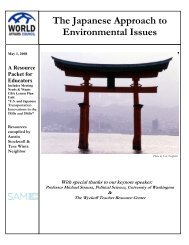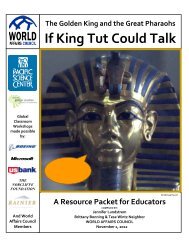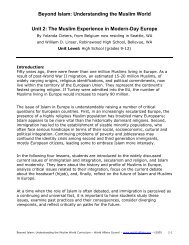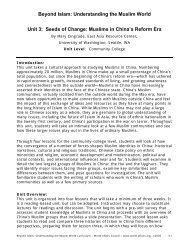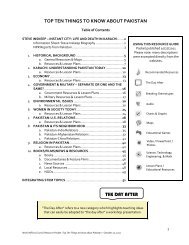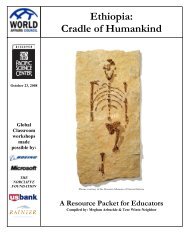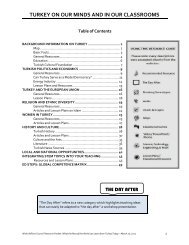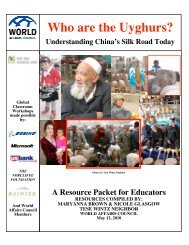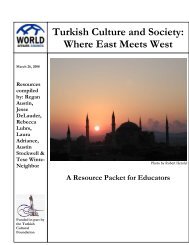The Question(s) of Tibet - World Affairs Council
The Question(s) of Tibet - World Affairs Council
The Question(s) of Tibet - World Affairs Council
You also want an ePaper? Increase the reach of your titles
YUMPU automatically turns print PDFs into web optimized ePapers that Google loves.
TIBETAN BUDDHISM/ART/ARCHITECTURE<br />
HIMALAYAN ART RESOURCES<br />
http://www.himalayanart.org/<br />
<strong>The</strong> mission <strong>of</strong> the Himalayan Art Resources website (HAR) is to create a comprehensive<br />
education and research database and virtual museum <strong>of</strong> Himalayan art.<br />
RUGS AND RITUAL IN TIBETAN BUDDHISM<br />
http://www.metmuseum.org/special/se_event.asp?OccurrenceId={8553DF5D‐9C4B‐4AF4‐<br />
B016‐EE653B334D0F}<br />
Thirty works dedicated to the enactment <strong>of</strong> <strong>Tibet</strong>an Vajrayana Buddhism, focusing on <strong>Tibet</strong>an<br />
tantric rugs as the seats <strong>of</strong> power employed by practitioners <strong>of</strong> esoteric Buddhism, form this<br />
installation. <strong>The</strong>se rugs typically depict the flayed skin <strong>of</strong> an animal or human and, together<br />
with associated ritual utensils, are the tools employed in the enactment <strong>of</strong> esoteric rites<br />
associated with protective deities. <strong>The</strong> employment <strong>of</strong> these images and ritual tools celebrate<br />
the power <strong>of</strong> detachment from the corporal body that advanced Buddhist practitioners strive to<br />
attain. It features two large ritual tangkas, together with the rugs upon which the practitioner<br />
sits, or upon which his ritual utensils are placed, as well as a rich assortment <strong>of</strong> associated ritual<br />
paraphernalia. Many are rarely seen objects from private collections. Curator John Guy<br />
discusses the ritual arts <strong>of</strong> <strong>Tibet</strong> and their role in the path to enlightenment, the subject <strong>of</strong> the<br />
installation.<br />
TIBETAN ARMS AND ARMOR<br />
http://www.metmuseum.org/toah/hd/tbar/hd_tbar.htm<br />
Armor and weapons are certainly not among the images usually called to mind when<br />
considering the art or culture <strong>of</strong> <strong>Tibet</strong>, which is closely identified with the pacifism and deep<br />
spirituality <strong>of</strong> the Dalai Lama and with the compassionate nature <strong>of</strong> <strong>Tibet</strong>an Buddhism.<br />
However, this seeming paradox resolves itself when seen in the context <strong>of</strong> <strong>Tibet</strong>an history,<br />
which includes regular and extended periods <strong>of</strong> intense military activity from the seventh to the<br />
mid‐twentieth century.<br />
DANCING DEMONS: CEREMONIAL MASKS OF ASIA<br />
http://sites.asiasociety.org/arts/mongolia/<br />
Among the great religious festivals <strong>of</strong> Asia, the ceremonies <strong>of</strong> Mongolia stand unsurpassed in<br />
the splendor <strong>of</strong> their visual imagery and their dramatic expressiveness. Dancing Demons:<br />
Ceremonial Masks <strong>of</strong> Mongolia presents spectacular examples <strong>of</strong> masks, costumes, and<br />
paraphernalia used in these ceremonies.<br />
MANDALA SAND PAINTING: CREATING AN ENLIGHTENED WORLD<br />
http://sites.asiasociety.org/arts/mandala/index.html<br />
Over a 10‐day period In September 2003 the <strong>Tibet</strong>an monks <strong>of</strong> Drepung<br />
Loseling Monastery constructed a sand mandala – a sacred cosmogram –<br />
"in commemoration <strong>of</strong> September 11 and as an <strong>of</strong>fering <strong>of</strong> peace and<br />
Through a Child’s Eye: An<br />
Especially Joyous Expedition<br />
<strong>of</strong> Mandalas<br />
http://kids.asiasociety.org/arts/<br />
mandala<br />
healing to the people <strong>of</strong> New York City." This archive website includes images showing day‐byday<br />
construction <strong>of</strong> the mandala, as well as the original press release describing the event, an<br />
interview with Geshe Lobsang Tenzin, founder and director <strong>of</strong> Drepung Loseling Institute, and a<br />
Teacher's Guide to the Mandala.<br />
<strong>World</strong> <strong>Affairs</strong> <strong>Council</strong> Teacher Resource Packet – <strong>The</strong> <strong>Question</strong>(s) <strong>of</strong> <strong>Tibet</strong> February 28, 2011<br />
38



